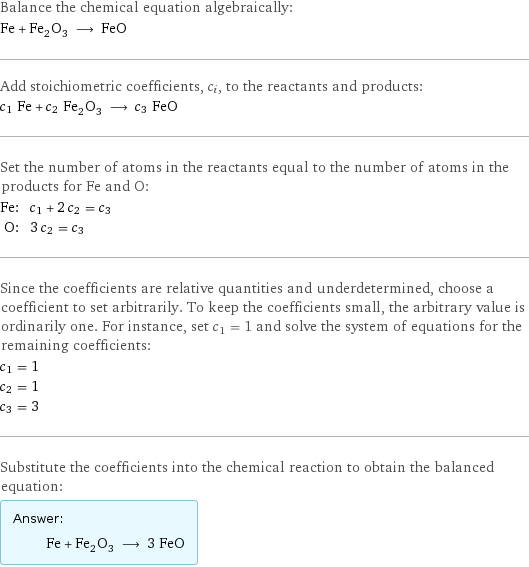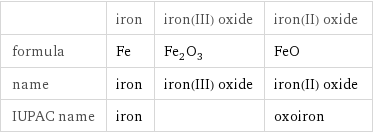Input interpretation

Fe iron + Fe_2O_3 iron(III) oxide ⟶ FeO iron(II) oxide
Balanced equation

Balance the chemical equation algebraically: Fe + Fe_2O_3 ⟶ FeO Add stoichiometric coefficients, c_i, to the reactants and products: c_1 Fe + c_2 Fe_2O_3 ⟶ c_3 FeO Set the number of atoms in the reactants equal to the number of atoms in the products for Fe and O: Fe: | c_1 + 2 c_2 = c_3 O: | 3 c_2 = c_3 Since the coefficients are relative quantities and underdetermined, choose a coefficient to set arbitrarily. To keep the coefficients small, the arbitrary value is ordinarily one. For instance, set c_1 = 1 and solve the system of equations for the remaining coefficients: c_1 = 1 c_2 = 1 c_3 = 3 Substitute the coefficients into the chemical reaction to obtain the balanced equation: Answer: | | Fe + Fe_2O_3 ⟶ 3 FeO
Structures

+ ⟶
Names

iron + iron(III) oxide ⟶ iron(II) oxide
Reaction thermodynamics
Enthalpy

| iron | iron(III) oxide | iron(II) oxide molecular enthalpy | 0 kJ/mol | -826 kJ/mol | -272 kJ/mol total enthalpy | 0 kJ/mol | -826 kJ/mol | -816 kJ/mol | H_initial = -826 kJ/mol | | H_final = -816 kJ/mol ΔH_rxn^0 | -816 kJ/mol - -826 kJ/mol = 10 kJ/mol (endothermic) | |
Entropy

| iron | iron(III) oxide | iron(II) oxide molecular entropy | 27 J/(mol K) | 90 J/(mol K) | 61 J/(mol K) total entropy | 27 J/(mol K) | 90 J/(mol K) | 183 J/(mol K) | S_initial = 117 J/(mol K) | | S_final = 183 J/(mol K) ΔS_rxn^0 | 183 J/(mol K) - 117 J/(mol K) = 66 J/(mol K) (endoentropic) | |
Equilibrium constant
![Construct the equilibrium constant, K, expression for: Fe + Fe_2O_3 ⟶ FeO Plan: • Balance the chemical equation. • Determine the stoichiometric numbers. • Assemble the activity expression for each chemical species. • Use the activity expressions to build the equilibrium constant expression. Write the balanced chemical equation: Fe + Fe_2O_3 ⟶ 3 FeO Assign stoichiometric numbers, ν_i, using the stoichiometric coefficients, c_i, from the balanced chemical equation in the following manner: ν_i = -c_i for reactants and ν_i = c_i for products: chemical species | c_i | ν_i Fe | 1 | -1 Fe_2O_3 | 1 | -1 FeO | 3 | 3 Assemble the activity expressions accounting for the state of matter and ν_i: chemical species | c_i | ν_i | activity expression Fe | 1 | -1 | ([Fe])^(-1) Fe_2O_3 | 1 | -1 | ([Fe2O3])^(-1) FeO | 3 | 3 | ([FeO])^3 The equilibrium constant symbol in the concentration basis is: K_c Mulitply the activity expressions to arrive at the K_c expression: Answer: | | K_c = ([Fe])^(-1) ([Fe2O3])^(-1) ([FeO])^3 = ([FeO])^3/([Fe] [Fe2O3])](../image_source/3e3689689f9ea2a5518ae7ed19c95007.png)
Construct the equilibrium constant, K, expression for: Fe + Fe_2O_3 ⟶ FeO Plan: • Balance the chemical equation. • Determine the stoichiometric numbers. • Assemble the activity expression for each chemical species. • Use the activity expressions to build the equilibrium constant expression. Write the balanced chemical equation: Fe + Fe_2O_3 ⟶ 3 FeO Assign stoichiometric numbers, ν_i, using the stoichiometric coefficients, c_i, from the balanced chemical equation in the following manner: ν_i = -c_i for reactants and ν_i = c_i for products: chemical species | c_i | ν_i Fe | 1 | -1 Fe_2O_3 | 1 | -1 FeO | 3 | 3 Assemble the activity expressions accounting for the state of matter and ν_i: chemical species | c_i | ν_i | activity expression Fe | 1 | -1 | ([Fe])^(-1) Fe_2O_3 | 1 | -1 | ([Fe2O3])^(-1) FeO | 3 | 3 | ([FeO])^3 The equilibrium constant symbol in the concentration basis is: K_c Mulitply the activity expressions to arrive at the K_c expression: Answer: | | K_c = ([Fe])^(-1) ([Fe2O3])^(-1) ([FeO])^3 = ([FeO])^3/([Fe] [Fe2O3])
Rate of reaction
![Construct the rate of reaction expression for: Fe + Fe_2O_3 ⟶ FeO Plan: • Balance the chemical equation. • Determine the stoichiometric numbers. • Assemble the rate term for each chemical species. • Write the rate of reaction expression. Write the balanced chemical equation: Fe + Fe_2O_3 ⟶ 3 FeO Assign stoichiometric numbers, ν_i, using the stoichiometric coefficients, c_i, from the balanced chemical equation in the following manner: ν_i = -c_i for reactants and ν_i = c_i for products: chemical species | c_i | ν_i Fe | 1 | -1 Fe_2O_3 | 1 | -1 FeO | 3 | 3 The rate term for each chemical species, B_i, is 1/ν_i(Δ[B_i])/(Δt) where [B_i] is the amount concentration and t is time: chemical species | c_i | ν_i | rate term Fe | 1 | -1 | -(Δ[Fe])/(Δt) Fe_2O_3 | 1 | -1 | -(Δ[Fe2O3])/(Δt) FeO | 3 | 3 | 1/3 (Δ[FeO])/(Δt) (for infinitesimal rate of change, replace Δ with d) Set the rate terms equal to each other to arrive at the rate expression: Answer: | | rate = -(Δ[Fe])/(Δt) = -(Δ[Fe2O3])/(Δt) = 1/3 (Δ[FeO])/(Δt) (assuming constant volume and no accumulation of intermediates or side products)](../image_source/dc1633c0d2a85079fc49f8661f5031fb.png)
Construct the rate of reaction expression for: Fe + Fe_2O_3 ⟶ FeO Plan: • Balance the chemical equation. • Determine the stoichiometric numbers. • Assemble the rate term for each chemical species. • Write the rate of reaction expression. Write the balanced chemical equation: Fe + Fe_2O_3 ⟶ 3 FeO Assign stoichiometric numbers, ν_i, using the stoichiometric coefficients, c_i, from the balanced chemical equation in the following manner: ν_i = -c_i for reactants and ν_i = c_i for products: chemical species | c_i | ν_i Fe | 1 | -1 Fe_2O_3 | 1 | -1 FeO | 3 | 3 The rate term for each chemical species, B_i, is 1/ν_i(Δ[B_i])/(Δt) where [B_i] is the amount concentration and t is time: chemical species | c_i | ν_i | rate term Fe | 1 | -1 | -(Δ[Fe])/(Δt) Fe_2O_3 | 1 | -1 | -(Δ[Fe2O3])/(Δt) FeO | 3 | 3 | 1/3 (Δ[FeO])/(Δt) (for infinitesimal rate of change, replace Δ with d) Set the rate terms equal to each other to arrive at the rate expression: Answer: | | rate = -(Δ[Fe])/(Δt) = -(Δ[Fe2O3])/(Δt) = 1/3 (Δ[FeO])/(Δt) (assuming constant volume and no accumulation of intermediates or side products)
Chemical names and formulas

| iron | iron(III) oxide | iron(II) oxide formula | Fe | Fe_2O_3 | FeO name | iron | iron(III) oxide | iron(II) oxide IUPAC name | iron | | oxoiron
Substance properties

| iron | iron(III) oxide | iron(II) oxide molar mass | 55.845 g/mol | 159.69 g/mol | 71.844 g/mol phase | solid (at STP) | solid (at STP) | solid (at STP) melting point | 1535 °C | 1565 °C | 1360 °C boiling point | 2750 °C | | density | 7.874 g/cm^3 | 5.26 g/cm^3 | 5.7 g/cm^3 solubility in water | insoluble | insoluble | insoluble odor | | odorless |
Units
